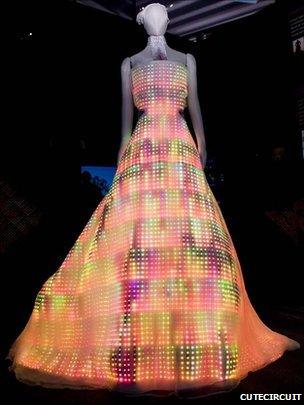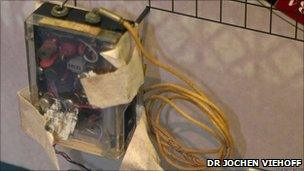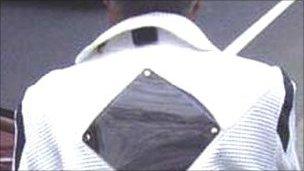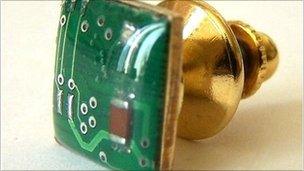Fashion buzz for stylish circuits
- Published

CuteCircuit's Galaxy Dress, festooned with 24,000 LED lights, is on display at a museum in Chicago.
Mobile phones, digital cameras, netbooks, e-readers and MP3 players. The list of must-have gadgets that must be crammed into pockets and bags is always increasing.
But now, researchers and fashion designers are working on ways to integrate technology into the clothes that we wear.
Will we one day be able to wear our gadgets rather than carry them around with us?
Since the creation of the very first wearable computer in 1961, generations of fashion designers, academics, computer programmers and scientists have been collaborating to create garments which fuse haute couture with hi-tech.
"We're at a time where we have fashion houses - people that understand garment construction - starting to explore with electrical engineers and scientists, to create products for a consumer market," said Dr Sabine Seymour, assistant professor of fashionable technology at Parsons, the New School for Design in New York.
One such team is CuteCircuit, which prototyped the M-dress, a mobile phone that is literally built into a frock. The antenna is in the hem and the SIM card, along with an activation button, fits into the dress label.
A sensor and microphone in the wrist enables the wearer to start and end a call by raising or lowering their arm to their ear. CuteCircuit plans to bring it to market in 2011.
"The M-dress was born out of necessity - I am always fishing around in my bag for my phone," said CuteCircuit co-founder Francesca Rosella. "I wanted something you could hear ring and answer in real time."
However, a concept such as the M-dress can take years to get to the shop floor - Ms Rosella and her partner Ryan Genz have been developing the idea since 2007.
Scientists at MIT, external have been designing keypads for clothing since the 1990s, but they have yet to enter the mainstream.

The first "wearable computer" was used in casinos to predict roulette results
So-called "wearable technology" has seen some of its biggest commercial successes in the field of sportswear, said Dr Seymour.
She cites breathable fabric Gore-tex and garments by the big sports clothing labels, which incorporate sensors monitoring an athlete's performance or heart rate, as examples of successful projects. Ski jackets that allow a wearer to control their MP3 player also exist.
"It is a good playground to test things out," she said. "Sport is one of the areas where functional wear designed with technology can really take off."
Love of lights
In the fickle world of fashion it is sometimes the more beautiful rather than the more practical creations which really turn heads.
CuteCircuit also makes glamorous evening dresses which incorporate LED lights controlled by a small electric circuit and powered by watch batteries stitched into the label.
Both popstar Katy Perry and Safura, a contestant at the 2010 Eurovision song contest, made headlines with dresses adorned with hundreds of flashing electric lights.

Designer Kouji Hikawa's jacket contains a solar panel on the back which powers a fan.
"Young people want to be playful, they want to have fun, they want their garments to be dynamic," said Ms Rosella.
"The mindset has changed. Wearable technology is becoming more mainstream, fashionable rather than geeky."
Using light in fashion design is a growing trend, according to Dr Seymour.
"There's an array of designers in this area doing interesting work," she said.
"But for me personally, the interest lies in a designed garment that has functionality and aesthetic. The more people are using it the more interesting it is to me - you can see the value being created."
Power to play
However, as clothing itself gets more hi-tech, so too does the power required to operate it.
"If you have a sensor on your body or if you have any type of equipment that needs to be electrically charged, you need energy for it," said Dr Seymour.
"Harvesting that energy is going to be a very powerful tool when we can use our own movement to do it - but it's not there yet."
Scientists are already working on nano fibres, which could be used harvest kinetic movement.
At the larger scale, mobile phone company Orange recently trialled a pair of wellington boots that could charge the phones of this year's Glastonbury festival goers via movement - but 12 hours of walking generated enough electricity to power a handset for just one hour.
Dr Seymour says that designers are now experimenting with clothing either made out of, or incorporating, solar panels.
"Lots of people are playing around with it, but it's not there yet with the consumer market," she said.
CuteCircuit designed its own electricity-conducting thread after finding that existing threads for that purpose generally contained copper or nickle, meaning that in many cases they either could not be washed or there was a risk of allergic reaction.
"We're designers but we're also engineers and material scientists," said Ms Rosella.
"When we first started the company we had to get engineers to make our designs, and they really couldn't get over the fact that we wanted a heart-shaped circuit".
Out of frustration Ryan Genz, whose background is in anthropology rather than electronics, learned how to make the circuits himself.
"He's the only person who has the patience to make a circuit look cute," said Ms Rosella.
Those unable or unwilling to take on all of those roles can turn to Dr Seymour, who has written a book, Fashionable Technology, about the growth of the sector.

Betsy Berberian uses circuit boards and brass to make vintage tie pins
She says a key part of her role involves getting people from the very different worlds of fashion design and technology to understand each other effectively.
"It's really about building trust in each other's expertise. We're taking a huge step forward - it's a completely different vocabulary."
But wearable technology is not only a career for the hi-tech pioneers.
Adam Brown of Etsy.com, a craft and vintage goods online marketplace, says there has been an increase in people selling traditional accessories crafted out of redundant electronics.
A trend called "upcycling" - taking items to be thrown away and creating something new - also lends itself to old gadgets that are beyond repair or simply too old to be of use.
"We see lots of accessories, jewellery in particular, made from electrical components," he told BBC Radio 5 Live's Outriders.
"They're things you don't see often, like resistors and circuit boards, but they're often in a wide variety of colours and shiny metals."
One such seller is Betsy Berberian.
"Three years ago an artist friend of mine was moving and she offered me a box of old beads and jewellery findings she didn't want," she said.
"Inside I discovered some ceramic computer circuits and fell in love with the intricate patterns. I started making jewel from the ceramic circuits and later I began cutting up and using the circuit boards in my poor, dead computers.
"My circuit jewellery is an escape from our throw-away world."
- Published2 August 2010